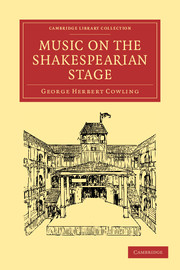Book contents
- Frontmatter
- PREFACE
- Contents
- LIST OF ILLUSTRATIONS
- Introduction
- CHAP. I Music in pre-Shakespearian drama
- CHAP. II An Elizabethan Stage and its music
- CHAP. III Musical instruments and their uses
- CHAP. IV Incidental music
- CHAP. V Musicians, Singers and Songs
- CHAP. VI Elizabethan music, and its share in the drama
- CHAP. VII Some literary allusions to music in Elizabethan plays
- Bibliography
- Appendix
- Index
- Frontmatter
- PREFACE
- Contents
- LIST OF ILLUSTRATIONS
- Introduction
- CHAP. I Music in pre-Shakespearian drama
- CHAP. II An Elizabethan Stage and its music
- CHAP. III Musical instruments and their uses
- CHAP. IV Incidental music
- CHAP. V Musicians, Singers and Songs
- CHAP. VI Elizabethan music, and its share in the drama
- CHAP. VII Some literary allusions to music in Elizabethan plays
- Bibliography
- Appendix
- Index
Summary
1. Frontispiece. A photograph, by Mr Emery Walker, of part of a picture in the National Portrait Gallery representing scenes from the life of Sir Henry Unton. The plate shows an Elizabethan consort playing music at his wedding-feast. A procession of masquers is filing past the musicians, who are seated around a table with their music before them. The instruments played by the consort, beginning at the left, are viol, flute, lute, cithern, viol da gamba, and probably pandore. The violist rests his instrument against the chest, and not, as do modern fiddlers, under the chin. The gambist is depicted in an impossible attitude, holding his bow by the point. Here, evidently, the painter was at fault. At the top of the stair, on the right, stands a drummer; and on the left, a quartet of singers are shown. The period is the last decade of the sixteenth century.
2. Plate I, p. 22 (from the Encyclopaedia Britannica, 11th Edition), is borrowed from an article in Shakespeare Jahrbuch, Vol. XLIV, entitled “The Fortune Theatre,” by Mr William Archer. The plate represents a reconstruction of the first Fortune Theatre, in Golding Lane, by Mr W. H. Godfrey, from the original specification furnished to one Peter Streete, a builder, on January 8th, 1600, by Philip Henslowe and Edward Alleyne. The indenture is quoted by J. P. Collier in his Annals of the Stage (3rd edn. 1831), Vol. III. p. 304. The theatre was eighty feet square outside, and fiftyfive feet square within.
- Type
- Chapter
- Information
- Music on the Shakespearian Stage , pp. 112 - 114Publisher: Cambridge University PressPrint publication year: 2009First published in: 1913

